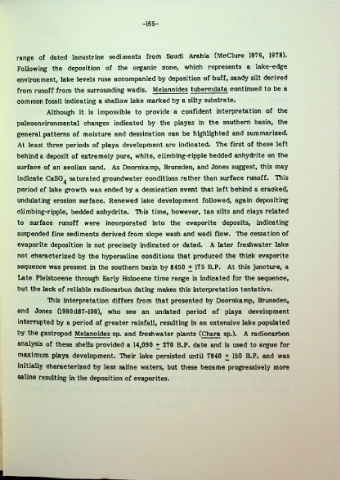Page 189 - Life & Land Use on the Bahrain Islands (Curtis E Larsen)
P. 189
-165-
range of dated lacustrine sediments from Saudi Arabia (McClure 1976, 1978).
Following the deposition of the organic zone, which represents a lake-edge
environment, lake levels rose accompanied by deposition of buff, sandy silt derived
from runoff from the surrounding wadis. Melanoides tuberculata continued to be a
common fossil indicating a shallow lake marked by a silty substrate.
Although it is impossible to provide a confident interpretation of the
paleoenvironmental changes indicated by the playas in the southern basin, the
general patterns of moisture and dessication can be highlighted and summarized.
At least three periods of playa development are indicated. The first of these left
behind a deposit of extremely pure, white, climbing-ripple bedded anhydrite on the
surface of an aeolian sand. As Doornkamp, Brunsden, and Jones suggest, this may
indicate CaSO^ saturated groundwater conditions rather than surface runoff. TTiis
period of lake growth was ended by a dessication event that left behind a cracked,
undulating erosion surface. Renewed lake development followed, again depositing
climbing-ripple, bedded anhydrite. TTiis time, however, tan silts and clays related
to surface runoff were incorporated into the evaporite deposits, indicating
suspended fine sediments derived from slope wash and wadi flow. Tlie cessation of
evaporite deposition is not precisely indicated or dated. A later freshwater lake
not characterized by the hypersaline conditions that produced the thick evaporite
sequence was present in the southern basin by 8450 + 175 B.P. At this juncture, a
Late Pleistocene through Early Holocene time range is indicated for the sequence,
but the lack of reliable radiocarbon dating makes this interpretation tentative.
'This interpretation differs from that presented by Doornkamp, Brunsden,
and Jones (1980:187-190), who see an undated period of playa development
interrupted by a period of greater rainfall, resulting in an extensive lake populated
by the gastropod Melanoides sp. and freshwater plants (Chara sp.). A radiocarbon
analysis of these shells provided a 14,090 + 270 B.P. date and is used to argue for
maximum playa development. Their lake persisted until 7840 + 150 B.P. and was
initially characterized by less saline waters, but these became progressively more
saline resulting in the deposition of evaporites.
I

